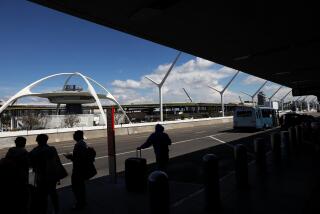New Air Control System Passes Test
WILMINGTON, Ohio — The future of air traffic control got a flight test Saturday as more than a dozen planes with satellite-positioning systems flew over Ohio and Kentucky while monitors tracked the exact location of each aircraft.
“November 40 confirms we see all the high traffic,” said the pilot of a Federal Aviation Administration Boeing 727 as he flew 26,000 feet over the Ohio River Valley. While clouds obscured the other planes from the eye, an airborne monitor clearly displayed the other test aircraft, cargo planes owned by United Parcel Service, FedEx and Airborne Express.
More accurate than radar and with a longer range than existing collision-avoidance systems, the “ADS-B” system simultaneously gave air traffic controllers and pilots an instant look at where the airplanes were to determine whether any were on conflicting courses.
Both airlines and the FAA say such immediate, widespread, pinpoint information will be needed if they are to address worsening congestion in the sky.
Such knowledge will permit air controllers to allow planes to leave the existing system of aerial highways that crisscross the nation and fly more direct routes chosen by pilots, a concept called “free flight.”
“The present system requires everyone to go down the same tubes,” said aviation analyst John Nance, a veteran airline pilot. “That limits the number of planes you can put in the sky.”
Since cargo airlines are leading the developing of ADS-B, it also may address a lingering safety problem: the lack of collision-avoidance systems in the nation’s burgeoning cargo fleet. Such equipment has been required in all but the smallest passenger planes since 1995, but cargo aircraft have been exempt.
The National Transportation Safety Board has complained to the FAA for years. Cargo pilots renewed their demands in 1997 after a UPS jumbo jet flew about 1,000 feet above and three miles to the left of Air Force One as President Clinton flew to Europe.
More than 600 million people fly through the United States each year. That figure is expected to top 1 billion by 2012, raising the possibility of massive delays.
The Cargo Airline Assn., a trade group representing the nation’s largest all-cargo carriers, has been working with the FAA and UPS Aviation Technologies on ADS-B, or Automatic Dependent Surveillance-Broadcast.
ADS-B uses the Global Positioning System, which features a constellation of satellites circling the globe, to determine an airplane’s speed, altitude and direction of travel. The information is updated several times a second.
More to Read
Inside the business of entertainment
The Wide Shot brings you news, analysis and insights on everything from streaming wars to production — and what it all means for the future.
You may occasionally receive promotional content from the Los Angeles Times.









